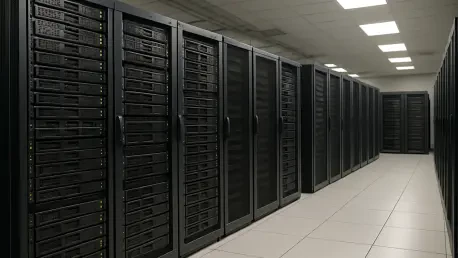In an era where technology evolves at a relentless pace, consider the staggering fact that data centers, the backbone of digital infrastructure, could become obsolete in less than a decade if not designed with foresight, especially as artificial intelligence and cloud computing drive unprecedented demand. The facilities powering global businesses face a critical challenge: adapt or fall behind. This feature dives deep into the innovative strategies reshaping data center design, uncovering how industry leaders are building resilience into the very foundation of these critical hubs.
The Urgency of Staying Ahead in a Digital Age
The stakes for data center design have never been higher. As AI workloads surge—consuming up to 10 times the power of traditional computing tasks—facilities built on yesterday’s blueprints struggle to keep up. Add to this the complexity of shifting regulations and resource scarcity, and it becomes clear why adaptability is no longer optional. The importance of this story lies in its impact: businesses risk catastrophic downtime and lost revenue if their infrastructure cannot evolve with the times. Future-proofing is the key to ensuring uninterrupted operations in an unpredictable landscape.
Beyond mere survival, the implications ripple across industries. From healthcare systems relying on real-time data to financial institutions processing billions of transactions, a single outage can spell disaster. Experts warn that without proactive design, many data centers risk becoming relics, unable to support the digital economy’s relentless growth. This exploration reveals not just the challenges but the actionable solutions driving the next generation of infrastructure.
The Looming Obsolescence of Today’s Infrastructure
Data centers face a ticking clock as technological advancements outpace traditional construction timelines. The rise of power-intensive applications means that a facility designed today might struggle to handle demands just a few years from now. Industry reports indicate that energy consumption in data centers could double by 2030 if current trends persist, highlighting the urgent need for designs that anticipate such exponential growth.
Moreover, regulatory pressures compound the problem. New sustainability mandates in regions like the European Union demand lower carbon footprints, pushing operators to rethink energy sources and cooling methods. Failure to comply could result in hefty fines or operational shutdowns. These external forces underscore that static planning is a recipe for obsolescence in a world where change is the only constant.
Foundational Elements of Resilient Design
At the heart of future-proofing lie three essential principles that guide modern data center architecture. Flexibility stands as the first pillar, moving away from rigid predictions toward adaptable layouts. Facilities with reconfigurable spaces can pivot to accommodate emerging technologies, such as next-generation cooling systems, without requiring costly overhauls.
The second pillar focuses on securing space and resources. Physical expansion, whether through additional land or vertical builds in urban areas, remains a non-negotiable factor. Equally critical is early access to power and water, as shortages in regions like the American Southwest already limit scalability for some operators. Planning for these elements from the outset prevents future bottlenecks that could halt growth.
Finally, scalable infrastructure ties these concepts together by balancing expansion with reliability. Decisions made during the initial design phase—such as utility allocations—directly influence a facility’s ability to grow without compromising uptime. These core elements provide a roadmap for building data centers capable of withstanding the test of time.
Voices from the Field on Tackling Uncertainty
Industry experts offer invaluable perspectives on navigating the unpredictable terrain of data center design. Madeleine Kudritzki from the Uptime Institute cautions that “designing for a specific future is a gamble; adaptability is the only safe bet.” Her insight reflects a growing consensus that rigid plans are no match for the rapid pace of innovation.
Chris Brown, also from the Uptime Institute, highlights the spatial challenges in densely populated areas, noting, “space constraints force a rethink of expansion—sometimes the only way is up, despite the engineering hurdles.” Real-world examples back this up: operators who embraced flexible designs during unexpected demand spikes avoided downtime that could have cost millions. These voices emphasize that resilience stems from anticipating change, not predicting it.
Their combined wisdom points to a shift in mindset. Rather than building for a fixed endpoint, successful designs prioritize frameworks that evolve. Stories of facilities adapting mid-operation—swapping out hardware or scaling power systems—demonstrate how expert guidance translates into tangible outcomes, saving businesses from the brink of failure.
Actionable Tactics for Building Lasting Facilities
Turning theory into practice, several strategies emerge for crafting data centers that endure. Adopting a flexible design mindset tops the list, focusing on spaces that can shift to support new hardware or cooling solutions. Layouts allowing for easy equipment upgrades ensure that a facility remains relevant as technology advances, minimizing disruption during transitions.
Planning for expansion from the initial stages is another critical step. Securing land or vertical build options in crowded regions prevents future limitations, while partnerships with utility providers lock in access to power and water. For instance, data centers in urban hubs have already faced delays due to resource unavailability, a pitfall that early planning can avoid.
Choosing the right capacity expansion model also plays a pivotal role. A phased approach, installing systems over time, offers cost savings but carries risks during integration, as untested components may fail under load. Conversely, a modular approach—using pre-tested capacity blocks—reduces failure risks but demands higher upfront investment. Tailoring this choice to an organization’s load needs and risk tolerance ensures a balance between budget and reliability.
Reflecting on a Path Forward
Looking back, the journey through the evolving world of data center design revealed a clear shift from static planning to dynamic adaptability. The challenges posed by soaring technological demands and resource constraints underscored a pivotal lesson: resilience requires foresight and flexibility. Each strategy discussed, from securing space to choosing expansion models, offered a piece of the puzzle in building infrastructure that lasts.
Moving ahead, stakeholders need to prioritize early planning and embrace adaptable frameworks as the cornerstone of their efforts. Collaborating with experts and utility providers stands out as a practical next step to mitigate risks. By embedding these principles into every design decision, the industry can ensure that data centers remain not just functional, but indispensable, no matter what challenges emerge on the horizon.









